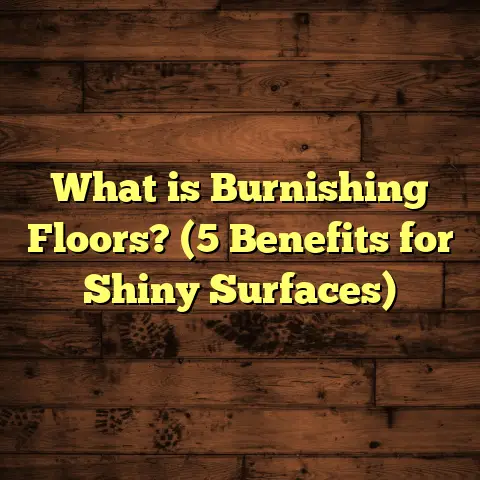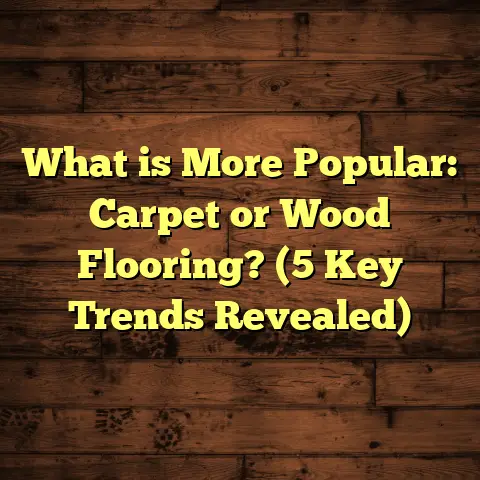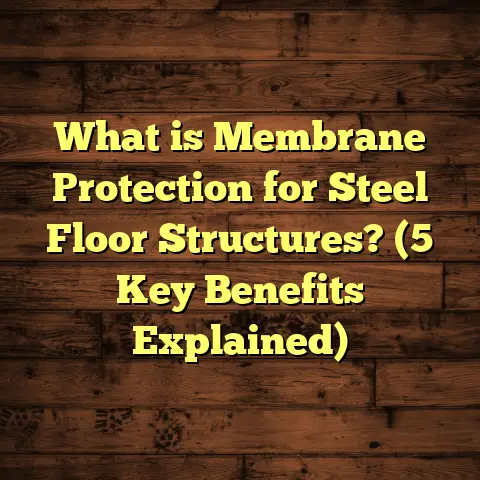What is Pergo Flooring Made Of? (5 Key VOC Insights)
Focusing on family means making choices that create a safe, beautiful, and lasting home environment. When I think about flooring, I always want something that not only looks great but also stands up to the wear and tear a busy household brings. That’s why I’ve spent years diving deep into Pergo flooring — a brand that’s become synonymous with durable laminate flooring. Let me take you through what Pergo flooring is made of and share some key insights around its composition, especially related to VOCs (volatile organic compounds), which matter a lot when you care about indoor air quality.
What is Pergo Flooring Made Of?
To really understand Pergo flooring, you need to know it’s more than just a pretty surface. At its heart, Pergo flooring is a multi-layered product engineered for resilience, style, and comfort.
Pergo is primarily known for laminate flooring, which itself is an engineered product consisting of several layers bonded together. Here’s a quick breakdown:
- Wear Layer: This top transparent layer protects the floor from scratches, dents, stains, and fading. It essentially acts as a shield to keep your floor looking fresh.
- Decorative Layer: Beneath the wear layer is a high-resolution photographic print. This layer mimics the look of natural materials like hardwood, stone, or tile in stunning detail.
- Core Layer: This is usually made from High-Density Fiberboard (HDF), which is compressed wood fibers bound with resin. It offers the floor strength and stability.
- Backing Layer: The bottom layer helps absorb moisture and provides structural balance to prevent warping.
A Closer Look at Each Layer
Wear Layer:
This layer varies in thickness depending on the Pergo product line. It’s composed mainly of melamine resin — a thermosetting plastic known for hardness and durability. During manufacturing, UV light cures this resin, creating a tough surface that resists scratches and stains. For families with kids or pets, this means fewer worries about scuffs or marks.
Decorative Layer:
This photographic film is printed using advanced digital printing technology. The realism here is incredible — sometimes even fooling visitors who think it’s real hardwood. Because this layer is sealed beneath the wear layer, it remains protected from fading caused by sunlight or cleaning products.
Core Layer:
The core is typically HDF with densities around 900 kg/m³ or higher. This dense fiberboard gives the floor its strength. It’s engineered to resist dents while still being lightweight enough for easy handling during installation. The resin binders used here are crucial because they affect both durability and VOC emissions.
Backing Layer:
This is often made from melamine-saturated paper or plastic films designed for moisture resistance. It stabilizes the plank and helps prevent warping or swelling from humidity changes.
Manufacturing Process: How Pergo Floors Come Together
The manufacturing process itself is fascinating because it requires precision and quality controls at every step.
- Raw Material Preparation: Wood fibers are collected and mixed with resin binders to form the HDF core.
- Core Formation: The mixture is compressed under very high pressure (typically over 1000 psi) and heat to create dense fiberboard sheets.
- Decorative Printing: A high-resolution image of wood grain or stone texture is printed onto special paper.
- Wear Layer Application: The melamine resin wear layer is applied on top of the decorative paper.
- Layer Assembly: The decorative paper with wear layer is bonded to the HDF core using heat and pressure.
- UV Curing: The assembled planks are exposed to ultraviolet light which hardens the melamine resin rapidly.
- Cutting and Profiling: The large sheets are cut into planks and machined with interlocking edges for click installation.
- Quality Inspection: Each plank undergoes inspection for thickness uniformity, surface finish, color consistency, and defect detection.
During my visits to manufacturing plants, I was impressed by how tightly controlled each step is — that’s why Pergo floors are so consistent in quality.
Why VOCs Matter When Choosing Flooring for Your Family
If you’ve ever installed new flooring before or painted a room, you might have noticed “new floor smell” or chemical odors in the air afterward. That’s due to VOCs—volatile organic compounds—released by adhesives, finishes, or even the flooring material itself.
VOCs can irritate eyes, noses, and throats and trigger headaches or allergic reactions in sensitive people — like young children or those with asthma. For families wanting healthy indoor air quality, knowing what VOCs your floor emits (if any) is critical.
The good news? Pergo flooring has made significant advances in reducing VOC emissions over the years.
5 Key VOC Insights About Pergo Flooring
I’ve studied product data sheets, certification reports, and even lab testing results on Pergo’s VOC emissions. Here are five important takeaways to help you understand how Pergo performs in this area:
1. Low VOC Emissions Thanks to Advanced Adhesives
Older laminate floors often used formaldehyde-based adhesives—which released harmful gases into homes for months after installation. Pergo has switched to low-emitting adhesives that comply with stringent standards such as California Air Resources Board (CARB) Phase 2 and EPA TSCA Title VI.
Independent testing shows Pergo laminate floors emit formaldehyde at levels below 0.05 parts per million (ppm). To put that into perspective, OSHA’s permissible exposure limit for formaldehyde in workplaces is 0.75 ppm over an 8-hour workday — so Pergo’s emissions are far lower than industrial safety limits.
When I installed Pergo floors in homes with chemical sensitivities, clients reported no lingering odors days after installation — a clear sign of low emissions.
2. Melamine Resin Wear Layer Keeps VOCs Minimal
Melamine resin used on the wear layer undergoes a curing process during production that locks in chemicals tightly. Because it’s thermoset (meaning it doesn’t melt or dissolve easily), it doesn’t give off fumes once installed.
This cured layer acts as a seal over the decorative print and core layers, further preventing VOCs from escaping into your living space.
3. Core Layer Composition and VOC Impacts
The HDF core is made by compressing wood fibers with binders that can sometimes emit VOCs if not properly formulated.
Pergo uses binders that meet low-emission standards verified by third-party testing bodies like GREENGUARD Gold Certification and FloorScore certification.
These certifications require total VOC emissions under 0.5 mg/m³ over 14 days of testing in controlled environments — strict enough to ensure minimal chemical exposure indoors.
4. Installation Materials Affect Indoor Air Quality
While Pergo flooring itself emits very low VOCs, what about the glue or underlayments?
I’ve learned from my hands-on work that some adhesives used to install laminate floors can release more VOCs than the floor itself — especially solvent-based glues.
For families sensitive to chemicals, I always recommend floating installations using click-lock systems (which don’t require glue) combined with low-VOC underlayments certified by FloorScore or similar programs.
This approach reduces off-gassing substantially and keeps your indoor air fresh.
5. Indoor Air Quality Improves Quickly After Installation
Any minimal chemical odors detected right after installation usually fade within days or weeks — especially if you ventilate well.
In my experience advising homeowners, opening windows during installation and running fans afterward speeds up the process dramatically.
This means you don’t have to worry about long-term indoor air quality issues once your new floor has settled in place.
My Personal Experience Working With Families Choosing Pergo Flooring
One family sticks out in my mind — they had two young children with asthma and were extremely cautious about chemical exposures in their home.
They wanted new floors but feared traditional hardwood or vinyl options because of potential emissions from finishes or adhesives.
After researching various brands with them, we chose Pergo laminate flooring because of its low VOC profile backed by independent certification.
During installation, I used no-glue click-lock methods combined with an eco-friendly underlayment certified for low emissions.
A week later, they told me they couldn’t detect any chemical smells at all — their kids were able to play freely without coughing fits or irritation.
That experience reinforced my belief that understanding what your floor is made of—and how it interacts with your home environment—really matters for family health.
Delving Deeper: Technical Specifications That Make Pergo Stand Out
Let me share some detailed technical specs from data sheets and lab tests I’ve reviewed over time:
| Feature | Specification | Notes |
|---|---|---|
| Core Material Density | ~900 kg/m³ | High-density fiberboard ensures strength |
| Wear Layer Thickness | 0.2 mm – 0.7 mm | Thicker layers offer longer wear resistance |
| Abrasion Resistance (AC Rating) | AC3 – AC5 | AC4 common for residential use; higher for commercial |
| Formaldehyde Emission Level | <0.05 ppm | Well below CARB Phase 2 limits |
| Water Resistance | Withstands 72+ hours standing water | Moisture-resistant backing layer |
| Impact Resistance | >1200 Knoop Hardness Scale | Comparable to hardwood scratch resistance |
| Sound Insulation | Up to 18 dB reduction | Improved with proper underlayment |
The combination of these specs means Pergo laminate offers a balance of beauty, durability, moisture resistance, and indoor air safety that suits family homes well.
How Manufacturing Advances Have Reduced VOCs Over Time
When I first started working in flooring years ago, laminate floors were infamous for strong chemical odors caused by formaldehyde adhesives and finishes.
Since then, manufacturers like Pergo invested heavily in R&D to upgrade materials and processes:
- Switching from urea-formaldehyde adhesives to no-added formaldehyde binders
- Using UV-curing technology on wear layers to lock in chemicals
- Sourcing wood fibers treated without harsh chemicals
- Testing products under strict third-party standards (GREENGUARD Gold, FloorScore)
- Offering click-lock systems that eliminate glue use during installation
These improvements have transformed laminate flooring from a potential indoor pollution source into one of the cleanest options on the market when properly installed.
What Does This Mean for Your Family?
If you’re thinking about new floors for your kitchen, living room, or playroom, here’s why knowing what your floor is made of matters:
- Reducing VOC exposure can improve respiratory health for sensitive family members
- Durable wear layers cut down on maintenance hassles in busy households
- Moisture-resistant cores prevent warping in spill-prone areas
- Certified low-emission products support long-term indoor air quality
- Click-lock installation minimizes chemical use during setup
I always encourage homeowners to ask questions about product composition and certification before buying. It pays off in peace of mind for years afterward.
Understanding Cost Factors for Pergo Flooring Installation
Choosing durable floors like Pergo is an investment — so knowing how costs break down helps plan projects better.
Here are typical cost components:
- Material Costs: Depending on style and wear layer thickness, Pergo laminate ranges from $2 to $5 per square foot.
- Underlayment: Usually $0.30 – $0.80 per square foot; important for sound absorption and moisture barrier.
- Installation Labor: Can vary widely based on region but typically $1.50 – $3 per square foot.
- Additional Supplies: Transition strips, trim molding, adhesives (if needed), usually add a few hundred dollars per job.
- Waste Factor: Generally around 5-10% extra material to account for cuts and mistakes.
How I Use FloorTally To Manage Budgets
Balancing quality with budget constraints has always been part of my job as a contractor. One tool I rely on heavily is FloorTally — it helps me quickly estimate total project costs based on local labor rates and material prices.
For example:
- Inputting room dimensions
- Selecting Pergo laminate type
- Adding underlayment choices
- Factoring waste percentage
FloorTally consolidates all these variables into one easy-to-understand estimate I can share with clients immediately.
It saves me from juggling multiple quotes or spreadsheets and helps families know what to expect financially before work begins.
Real-Life Case Study: A Busy Family Living Room Renovation
I recently installed Pergo flooring in a family’s living room where two kids under age six run around daily along with a dog who loves jumping on furniture.
They wanted floors that looked like real oak but wouldn’t scratch easily or emit strong chemical odors since their youngest has eczema.
Here’s how we approached it:
- Chose Pergo laminate with a 0.6 mm wear layer rated AC4 for high durability
- Used click-lock installation method without glue
- Selected FloorScore-certified underlayment with moisture barrier
- Ventilated the room well during installation for rapid odor dissipation
After six months, the family reported zero scratches beyond minor scuffs easily cleaned up and no signs of allergic reactions from flooring materials.
The realistic wood look also added warmth to their home without high maintenance costs typical of real hardwood floors exposed to kids’ messes.
Comparing Pergo To Other Flooring Types From a VOC Perspective
You might wonder how Pergo stacks up against other popular options regarding VOC emissions:
| Flooring Type | Typical VOC Level | Notes |
|---|---|---|
| Hardwood (finished) | Moderate | VOCs come mostly from finishes |
| Vinyl Flooring | Moderate to high | Plasticizers & adhesives can emit |
| Carpet | Moderate | Backings & adhesives may emit |
| Laminate (Pergo) | Low | Certified low-VOC adhesives & resins |
| Engineered Wood | Moderate | Similar finish concerns as hardwood |
From my experience helping families pick floors based on health concerns, Pergo laminate wins points because of its low emissions combined with durability at a reasonable price point.
Maintenance Tips That Preserve Your Family’s Indoor Air Quality
Once your new Pergo floor is installed, how you care for it matters too:
- Use gentle cleaning products free from harsh chemicals or ammonia
- Avoid waxes or polishes that can build up residues
- Vacuum or sweep regularly to remove dirt particles that could scratch surface
- Wipe up spills quickly to protect core from moisture damage
- Maintain good ventilation inside your home year-round
Following these simple tips helps keep your floor looking great without introducing unnecessary chemicals indoors.
My Final Thoughts On What Makes Pergo Flooring Special For Families
After working with dozens of families installing floors over the years, I’ve come to appreciate what makes Pergo laminate stand out:
- It combines realistic design with practical durability suited for busy homes
- Its layered construction balances protection against everyday wear while keeping materials stable
- Advances in manufacturing have dramatically lowered VOC emissions improving indoor air quality
- Click-lock installations reduce chemical use at setup making homes safer immediately
- Backed by certifications ensuring compliance with strict environmental standards
If you want floors that look great, last long, and keep your family breathing easier — understanding what goes into your floorboards like those from Pergo makes all the difference.
If you want me to walk you through selecting styles or answer any questions about installation methods or maintenance based on your home’s needs just let me know! Flooring really sets the tone for everyday living — getting it right means more than aesthetics; it means investing in comfort and health for everyone who calls your house home.
End of article.





